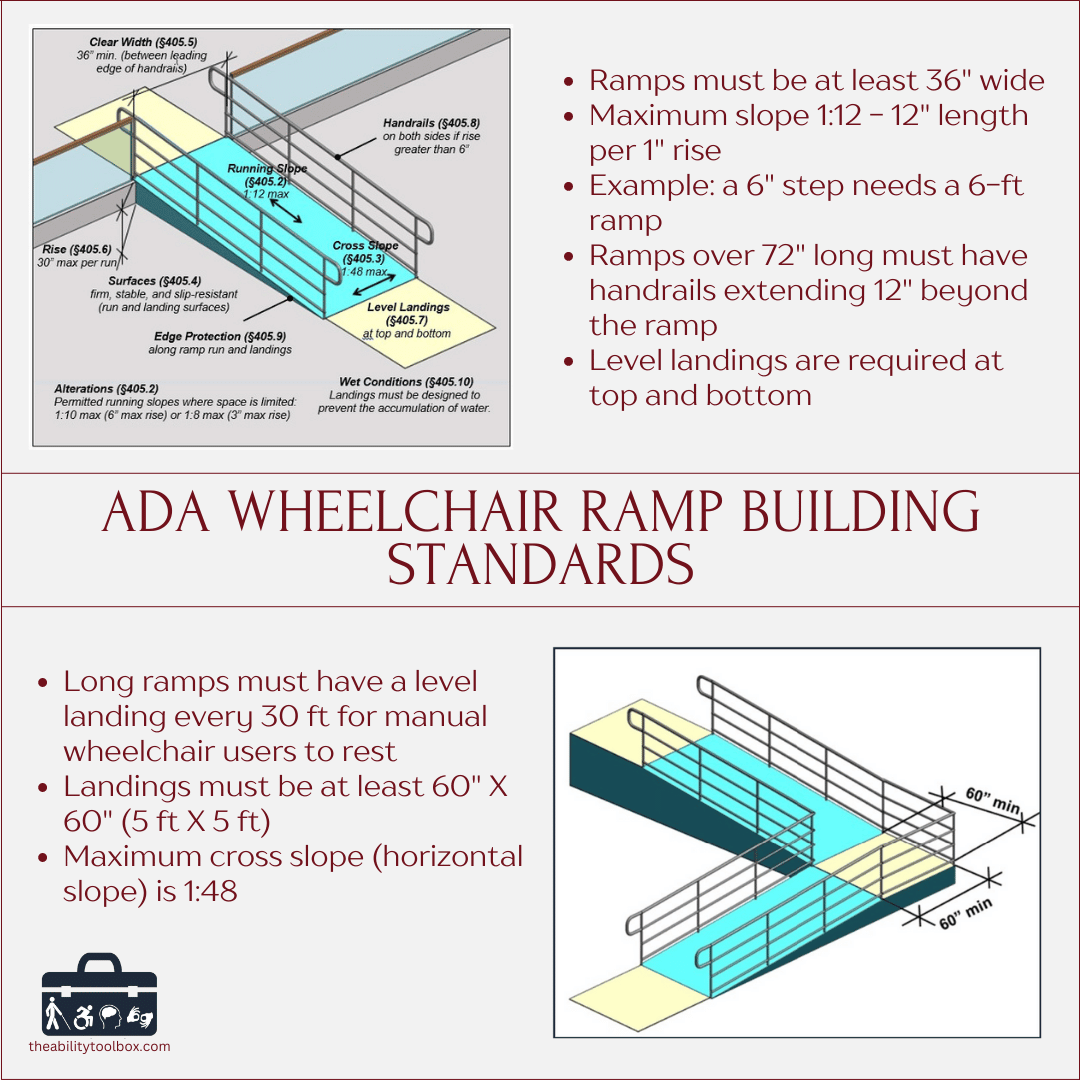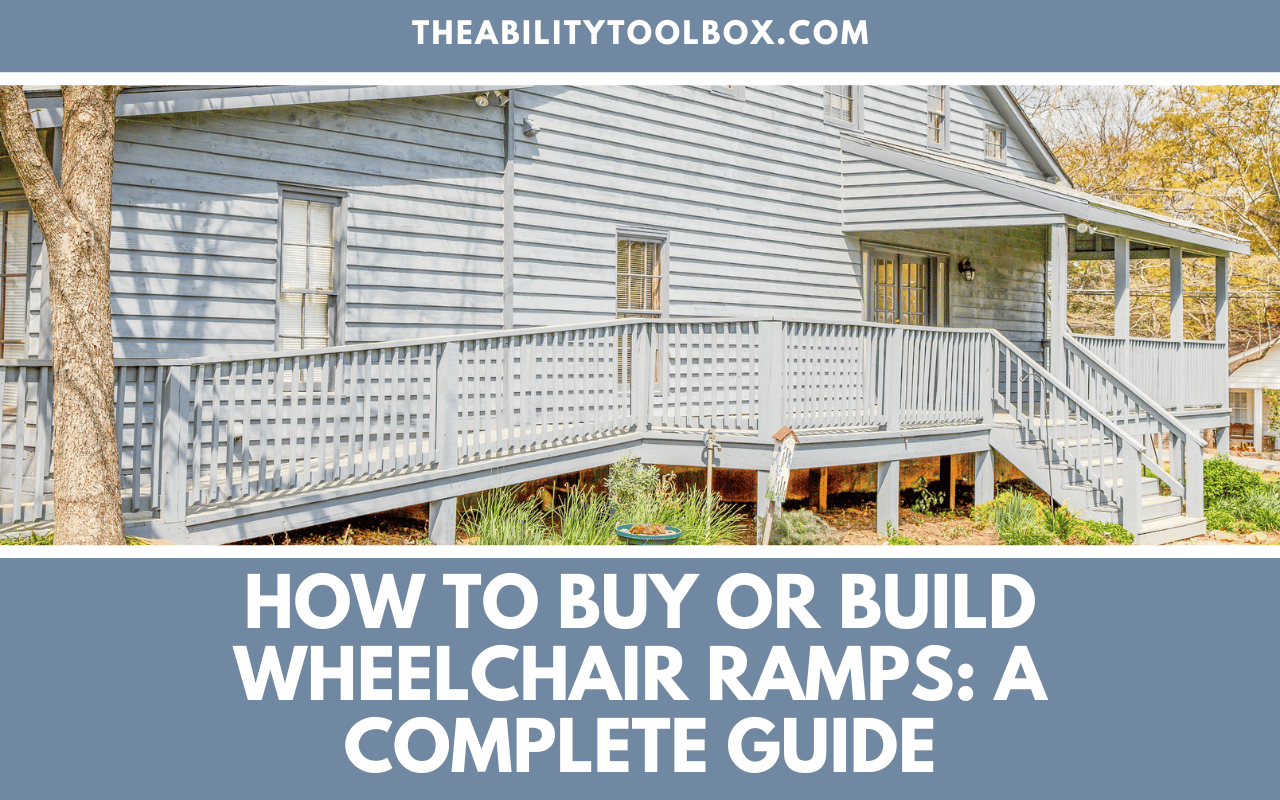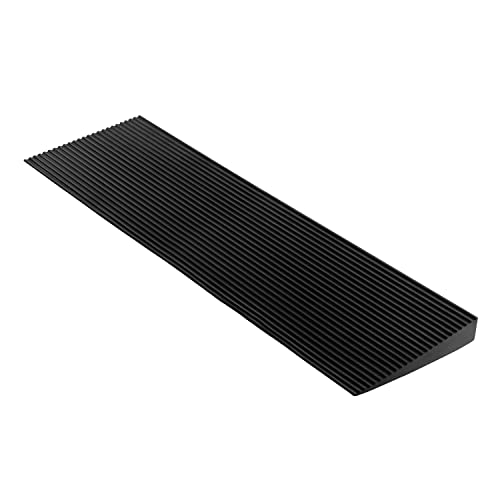This page contains affiliate links, which means if you choose to make a purchase, we may earn a commission at no additional cost to you. As an Amazon associate, we earn from qualifying purchases.
Introduction to Wheelchair Ramps
The lack of accessibility in our communities makes daily life extremely challenging for people with disabilities. Although the Americans with Disabilities Act has been the law for over 30 years, far too many businesses are still inaccessible to people who use wheelchairs, scooters, and other mobility devices. I find what I call the one-step problem to be especially galling — businesses that have just one step at the entrance. This is simple and inexpensive to fix, yet tens of thousands of businesses have not bothered to do so. If you're one of those businesses, whether you've been dragging your feet about it for years or just moved into a space with a step and recognize that accessibility is both legally and morally necessary, this guide will help you quickly remedy the problem and make your store welcoming to all.
If you or a loved one has a mobility disability, you may also have noticed that most apartments and houses have steps. Searching for accessible housing can be frustrating, and you'll be lucky to find a home with just one or two steps at the entrance. That means you'll need a wheelchair ramp, which is probably what brought you here. I hope this guide will make it easy for you to find what you need so you or your loved one can fully enjoy your new home and community.
Wheelchair Ramp Measurements and Requirements
If you are buying or building a wheelchair ramp, you'll need to consider any legal requirements and regulations that apply to your building, or your personal needs if the ramp is for private residential use. Here are the factors to consider:
ADA Regulations for Wheelchair Ramps for Public Buildings
The Americans with Disabilities Act requires that wheelchair ramps meet specific standards to ensure safety and usability.
- For every 1 inch of rise, you need 12 inches of ramp length, a 1:12 slope. This slope is very gentle and designed for people using manual wheelchairs who may not have a lot of strength. The calculations for this are very simple — you need 1 foot of length for every 1 inch of rise. So for a 6-inch step, you need a 6-foot ramp.
- Ramps over 6 feet in length must have handrails that extend 12″ beyond the ramp length
- Ramps over 30 feet must have a minimum 5′ x 5′ level landing between sections to allow manual wheelchair users to rest.
The diagram below illustrates the proper measurements for ADA-compliant wheelchair ramps.

Wheelchair Ramps for Private Home Use
How to Choose the Right Length for a Wheelchair Ramp
Wheelchair Ramp Weight Capacity
Types of Wheelchair Ramps
There are many different kinds of wheelchair ramps available. While some are permanent, many are portable for travel, and others can be easily installed without making changes to the structure of a home and removed when no longer needed. Here are some examples, along with suggestions for when and where to use them.
Threshold Wheelchair Ramps
Portable Wheelchair Ramps
Modular Wheelchair Ramps
Modular wheelchair ramp kits are designed for permanent or semi-permanent installation in situations where a longer ramp is needed. Let's take a look at the advantages and disadvantages of these kits so you can decide if one is right for you.
Advantages of Modular Wheelchair Ramps
- Easy to buy: Simply measure your steps and choose the correct ramp length and landings.
- Easy assembly and installation: All instructions and materials are included.
- Strong and durable: Metal ramps will last many years. They are less vulnerable to damage from water and de-icing chemicals.
- Semi-portable: Metal ramps can be disassembled and taken with you when you move or sold if no longer needed.
Disadvantages of Modular Wheelchair Ramps
- Ugly: Nobody wants to attach one of these metal monstrosities to their front porch unless they have no other options. Seriously, the designers of these ramps need to do better. Aesthetics matter and people with disabilities are tired of being stuck with unattractive equipment.
- Expensive: Due to the materials (and the disability tax), these ramps are costly to purchase.
- Noisy: Metal ramps can be creaky and make unpleasant sounds as a wheelchair rolls on them, especially a heavy power chair.
How to Build Your Own Wheelchair Ramp
If you need a long wheelchair ramp or you want a ramp that blends aesthetically with your home's exterior, building your own (or hiring a handyperson) is often the best and least expensive option. Most homemade wheelchair ramps are constructed from wood, but you can also use a composite material like Trex. If you live in a wet or snowy climate, it will last longer!
I recommend the DIY wheelchair ramp kit below to help you get started. It gives exact instructions for the materials you'll need to purchase from your local hardware store and comes with fittings for easy assembly.
How to Make a Wheelchair Ramp Look Good
Let's face it, many wheelchair ramps, especially pre-made ones, are not very attractive. Manufacturers need to care more about making mobility products look good! These tips will help you build an aesthetically-pleasing ramp or give a not-so-appealing ramp a makeover.
- If possible, I recommend replacing a home's front walk to provide a seamless entrance in concrete; this works great for 1-2 steps if you have enough space. If you need something less permanent and/or cheaper, placing a ramp over the existing path is still a good idea.
- It's OK to replace or cover the existing steps — able-bodied people can use the ramp too.
- Wood and composite are far more attractive than metal and can be stained or painted to match your home. Be sure to use side railings that match your home's exterior.
- Add decorative or solar light caps to the tops of posts to make them more attractive and functional.
- Plant bushes along the side of the ramp to hide it. If you use the handrails, avoid vines or climbing plants that may wrap around them. You can also install raised beds and plant flowers or vegetables within easy reach.
- Build a fence or use temporary fence panels to hide an unattractive metal ramp.
- Add an outdoor carpet runner. This can reduce the creaking and rattling of metal ramps.
- Build a ramp in the garage. That way you don't have to worry about whether it matches your exterior.
Tips for Finding or Building an Affordable Wheelchair Ramp
If you live on a fixed income as many people with disabilities do, it can be difficult to find a low-cost wheelchair ramp. Here are a few tips for accessing affordable equipment and financial support.
1. Search for used ramps for sale online.
You can often find practically new or lightly used ramps for sale online or locally from people who purchased them for an elderly relative and no longer need them. I've seen modular metal wheelchair ramps for half the cost of retail on Facebook Marketplace.
EBay is another great place to find used and discount wheelchair ramps. Here's a sampling of just a few of those currently available.
2. Build a LEGO wheelchair ramp.
Yes, you can build a ramp out of LEGOs! They work best for one, maybe two steps, and the only cost is the LEGOs and your time to assemble them. To learn more, check out Ability Magazine's article about the LEGO Grandma, who pioneered this concept in Germany.
3. Contact your local Center for Independent Living for resources.
Centers for Independent Living are nonprofit disability-led organizations that help people access equipment and services. Some centers have an equipment library or donation program for mobility aids and may have small ramps available. They can also help you find local organizations that will assist you with building or buying a ramp.
4. Pursue assistance from government programs such as the Veterans Administration, Medicaid, and Vocational Rehabilitation.
Various state and federal agencies offer assistance with making your home accessible. If you receive Medicaid, search for “Medicaid home modifications [your state]” to find out what services are available. If you work or you're seeking employment, your state Department of Vocational Rehabilitation will pay for modifications that enable you to get or keep a job, including a ramp, accessible bathroom, kitchen remodel, etc.
For more complex and expensive remodels, state and federal programs can be extremely helpful. However, it can take a minimum of several months and potentially two or more years to get through the complicated process of receiving assistance. Therefore, if you are unable to get in and out of your home, I recommend trying every other option on this list first. Your best plan is to purchase a basic ramp or find local volunteer help, and then work with government funding sources for bathroom and kitchen access.
Learn More About Wheelchair Accessible Housing
This guide is part of a series on wheelchair accessibility. Check out our other articles for further resources.
Do you have advice about wheelchair ramps?
I hope the information in this article will assist businesses, landlords, and homeowners with buying or building a wheelchair ramp so we can create a more accessible world for all. If you have more resources to suggest, please leave a comment below or contact us and we will update this article periodically. If we share knowledge, we can make life better for us all.
Founder and Editor-in-Chief of The Ability Toolbox. I received my BA in English from Stanford University and MA in Clinical Psychology from Antioch University Los Angeles, and have worked in entertainment and health media for over 20 years. I also blog about traveling with a disability. As a wheelchair user with cerebral palsy, I am deeply committed to amplifying the voices of the disability community through writing and advocacy.


































